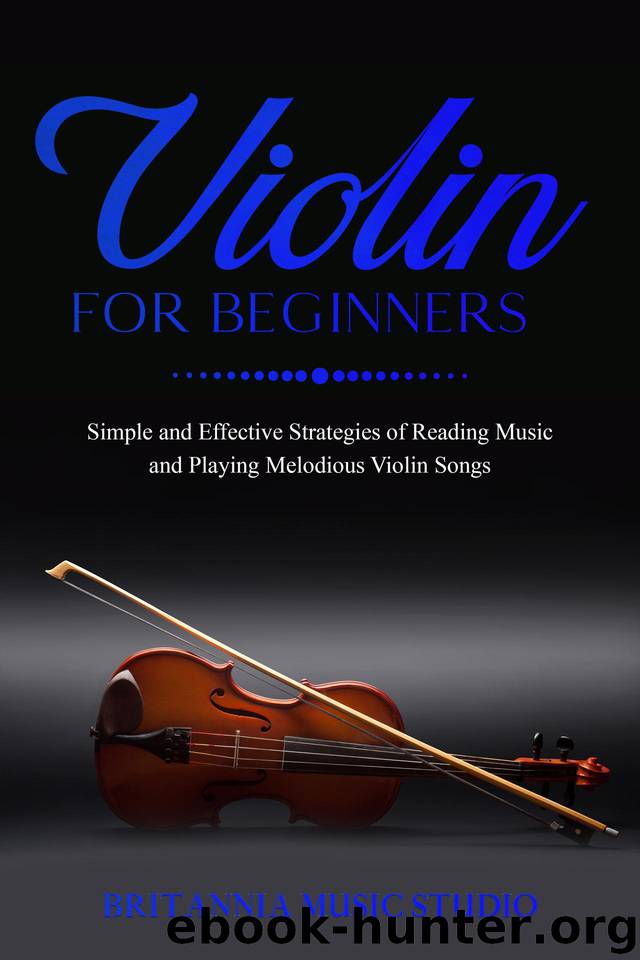Violin for Beginners: Simple and Effective Strategies of Reading Music and Playing Melodious Violin Songs by Music Studio Britannia

Author:Music Studio, Britannia
Language: eng
Format: azw3, epub
Published: 2020-06-16T16:00:00+00:00
Chapter 10: Building Left Hand Technique
As you work to refine your basic left-hand technique, you will find that eventually, you want to play more complex music as a beginner violinist. A lot of beginner music begins by playing just one note at a time in consecutive order, which is an excellent foundation for beginner music. What if you are ready to move beyond? This is where practicing scales, arpeggios, etudes (French for 'studies'), and solo music come into play. Pull out your tuner, metronome, and a pencil. It is time to build up your left-hand technique!
Scales and Arpeggios Strategy
There is nothing quite as effective in your violin studies as working on your scales and arpeggios. Each scale comes with an arpeggio unique to the scale, with the arpeggio played right after the scale. As a beginner, you will start by studying one to two-octave scales in major and minor key signatures, ranging in sharp, natural, and flat keys. Do not worry if this sounds like a lot. Once you have the formula of a scale internalized, you will be effectively able to practice any simple scale on the violin.
What is a scale, anyway? Well, a scale is a series of notes that begins and ends on the same note in a step by step sequence. Think of elementary music class, when you had to learn the musical syllables Do Re Mi Fa Sol La Ti Do. Essentially, this is an aural formula for building a scale. If you can look up a scale recording or video, I highly recommend it. No book will ever be able to clarify for you what a music scale sounds like if you do not know what it sounds like already. Sound before sight, after all. However, let us say that you already know what a scale sounds like, and have been practicing your scales already. Let us look at an example of an A major scale; one octave is built like this:
A B C# D E F# G# A
Do not worry about why some notes are sharp for now. The most important thing is to learn what scales sounds like, where these notes are on the violin, and how to play them. There are some fabulous instructional videos available for free online if you would like to like how to play the one octave A major scale on your violin. When you practice your scales, you will go up the scale, and then go back down the scale in reverse order. As you play the scales, your intonation is paramount. Always listen and adjust quickly if you hear a note out of tune. Work on playing each scale using different rhythms, bowings, and metronome speeds as part of your daily practice routine. Not sure if you're in tune? Use a tuner for specific feedback or turn on a drone set to the name of the scale being played and adjust your notes to it.
Right after the scale, we practice the scale's corresponding arpeggio. An
Download
Violin for Beginners: Simple and Effective Strategies of Reading Music and Playing Melodious Violin Songs by Music Studio Britannia.epub
This site does not store any files on its server. We only index and link to content provided by other sites. Please contact the content providers to delete copyright contents if any and email us, we'll remove relevant links or contents immediately.
The Goal (Off-Campus #4) by Elle Kennedy(13543)
Kathy Andrews Collection by Kathy Andrews(11730)
Diary of a Player by Brad Paisley(7487)
What Does This Button Do? by Bruce Dickinson(6134)
Assassin’s Fate by Robin Hobb(6127)
Big Little Lies by Liane Moriarty(5702)
Altered Sensations by David Pantalony(5045)
Pale Blue Dot by Carl Sagan(4912)
Sticky Fingers by Joe Hagan(4101)
The Death of the Heart by Elizabeth Bowen(3551)
The Heroin Diaries by Nikki Sixx(3493)
Beneath These Shadows by Meghan March(3262)
Confessions of a Video Vixen by Karrine Steffans(3245)
How Music Works by David Byrne(3187)
The Help by Kathryn Stockett(3082)
Jam by Jam (epub)(3023)
Harry Potter 4 - Harry Potter and The Goblet of Fire by J.K.Rowling(2990)
Strange Fascination: David Bowie: The Definitive Story by David Buckley(2798)
Petty: The Biography by Warren Zanes(2697)
